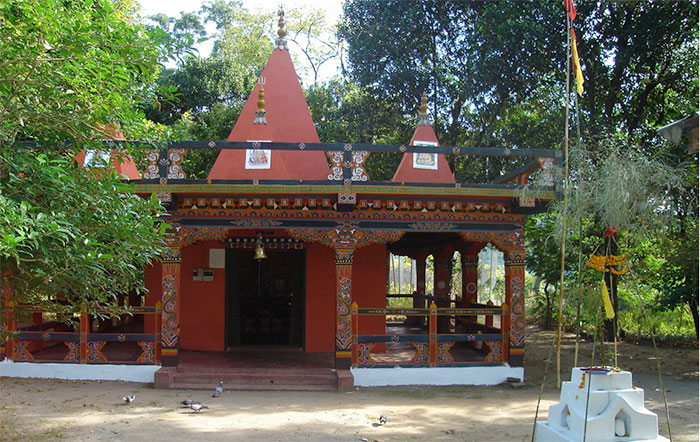The monasteries and temples that dot the cultural landscape of Bhutan are woven with inspiring religious stories and mythologies find physical and metaphysical evidence in their holy sites. The small but sacred Bhairab Kunda Shiva temple in Jomotshangkha town, located at the tri-junction of Bhutan and the Indian states of Arunachal Pradesh and Assam, is no different.
Religious significance
According to Hindu mythology from the Sosthani Vratakatha and the Shiv Mahapuran, Lord Shiva wandered the earth upon the bereavement of his beloved Satti Devi. Lord Shiva was inconsolable and was unconsciously wandering, carrying the corpse of Satti Devi on his shoulder. This worried other Gods and Goddesses because without Lord Shiva’s attention, the whole world would suffer. Therefore, Lord Vishnu created flies to carry germs to disintegrate the lifeless body of Sati Devi. The flies carried germs and they started disintegrating her body. Part-by-part, her body decayed and fell off in different places on earth as Lord Shiva wandered. Wherever her body parts fell, the place assumed supernatural energy known in Hindu mythology as the Shakti Peeth. The folklore says that parts of the Satti Devi fell on 51 locations. Many sites are identified in India, Nepal, Pakistan, Sri Lanka, and China. However, one such Shakti Peeth is identified and referenced in the Shiva Maha Puran and the Sosthani Varat Katha as the Bhairab Kunda.
These two prominent references further state that The King of the Gods, Lord Indra descended on his Airavat, the celestial White Elephant and came to the Shakti Peeth. Lord Indra offered his respect to the place and meditated there for many years. He conducted many fire rituals to seek first blessings from the place. Lord Shiva pleased with the devotion of Indra blessed with the place with rain. Therefore, Indra is regarded as the God of lightning, thunder, storms, rains, streams, and rivers. Thus, it’s said that even today, upon the conduct of a fire ritual, immediate rainfall is experienced in Bhairab Kunda.
Another myth specific to the site states that Lord Shiva meditated at a cave located just below the present temple and a lake (Kunda) was formed at the site of meditation. Years later, Bhairab Nath, a fierce manifestation of Lord Shiva was meditating at the same place he discovered a Shiva Ling, an abstract representation of Shiva and the place got its name “Bhairab-Kunda (Lake)”.
Architectural style and relics
It is difficult to trace the original form of the temple but a visit to the place reinforces the mythology with enough physical and material evidence to reveal the sanctity of the place. Oral history also says that the original lake burst during an 8.6 magnitude Assam earthquake in 1950 leaving the Shiv Linga on the bed of the lake. The remains of the lake can still be seen at the site today. Devotees relocated the sacred relics to the present site where a wooden temple was built to house the Shiv Linga.
History and heritage of the place were diluting with the place itself due to lack of resources before the community came together to start crowdfunding for the construction of a permanent temple in 2002. Devotees from all over Bhutan made voluntary contributions to fund that helped in the construction of the present temple, completed in 2005. Today, the temple is one of the major religious monuments and a pilgrimage site in the drungkhag and in the region.
Bhairab Kunda Temple combines elements of Hindu temple and traditional Bhutanese architecture. Picture.
The temple is located at the easternmost corner of the town and is accessed via a footpath from the road leading to the NHDCL housing colony. A large banyan tree forms the foreground of the temple complex almost hiding the temple completely until the visitor reaches in front of it. The main temple is a single-story structure with a unique architectural style combining the elements of a Hindu temple on the top and traditional Bhutanese architecture at its base columns. The main temple is a 6-metre square and has a 1.5-metre corridor all around and an inner shrine. The inner sanctum has the self-originated Sila which is a naturally formed rock. A recently constructed lake with a statue of Shiva is located on the eastern part of the complex beside the round rock which is worshipped as Ganesh deity. The are many statues of Hindu Goddesses and Gods inside the shrine including a pair of Radha-Krishna Statue that was gifted by His Majesty The King.
Maha Shivaratri is the most important festival celebrated at the temple each year. Prayers from Vedas, Rudri, Chandi, Shrimad Bhagawat, Shiva Maha Puran are offered during the festival for the well-being of the local community and the country. Thousands of devotees from the neighbouring Indian state of Assam also attend the events at the temple. Popular Hindu festivals like Makar Sankranti, Dashain, Deepawali, Janam Ashtami, Ram Navami, are also celebrated with great enthusiasm by both local and the pilgrims.
Significance for Bhutan
The location of the temple at the trijunction of Bhutan and two Indian states provides an opportunity to weave the significance of the temple with that of the region and promote the town as a tourist destination, complement other destinations like the Jomotshangkha Wildlife Sanctuary, as well as promote people-to-people contacts and Bhutan India Friendship. It is hoped that the Hindu Dharma Samudaya of Bhutan will initiate prayers to seek blessings from the spiritual power of the temple to end the current pandemic and the power of Lord Indra to bring rain to the Bhutanese settlements experiencing water shortage.
Contributed byDhrubaraj Sharma
QUT Design Lab


